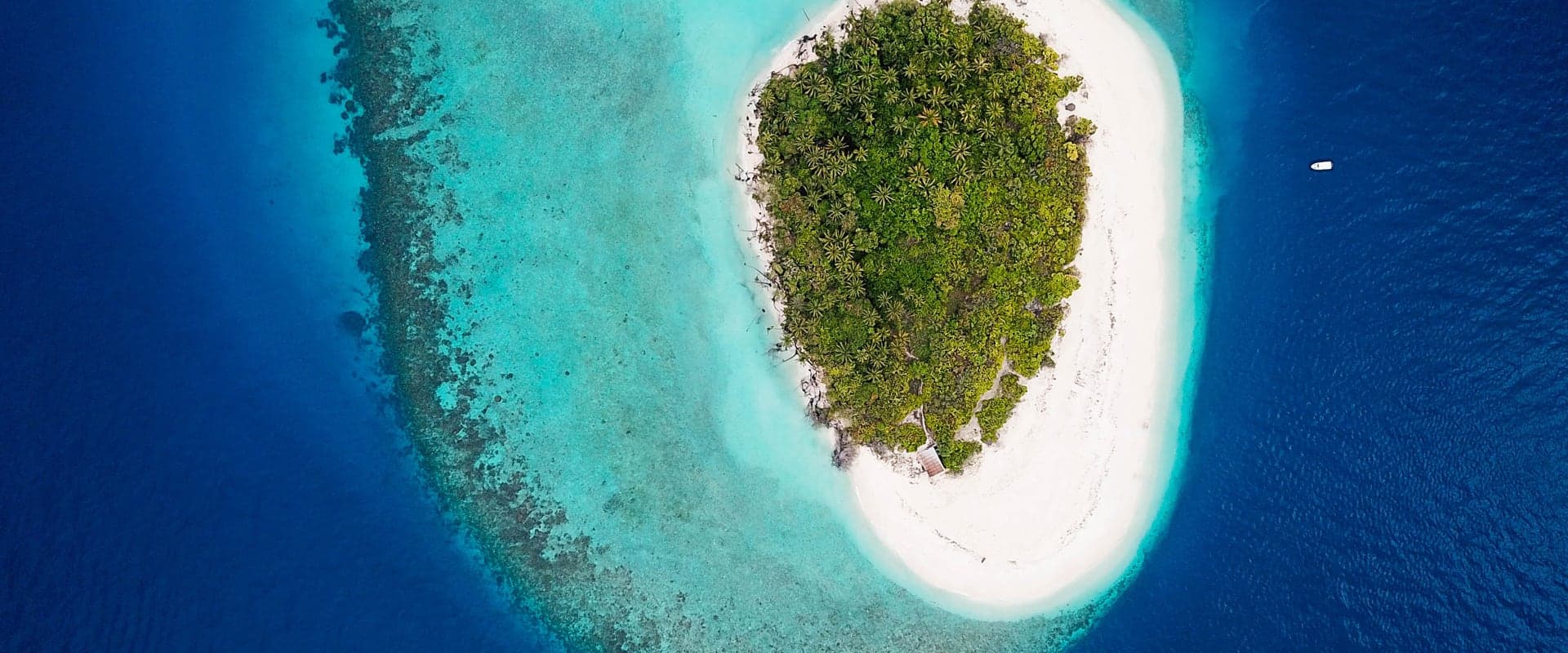Diving in the Maldives
Maldives diving has been described as "phenomenal", thanks to the warm, clear, nutrient-rich waters. The Northern Atolls reefs are covered with soft corals and sponges, whilst the Southern Atolls host a plethora of sharks, including hammerheads.
Scuba diving in the Maldives means diving at one of the worlds best scuba diving destinations, because of the white sand beaches, coral reefs, clear warm waters, best dive sites and rich marine life. The Maldives consists of many small islands that are grouped in 26 atolls in the Indian Ocean. All of the islands have white sand beaches and many have luxury resorts to comfort your stay at the island. Because the Maldives consists of groups of small islands, Maldives scuba diving means diving in channels with caves, caverns and overhangs that are covered with soft corals, colourful sponges, invertebrates and gorgonian fans.
The Maldivian nutrient-rich waters that flow through these channels and the pinnacles feed the sponges and soft corals that cling on to the rocks and this in turn attracts an abundant amount of marine life which makes diving in the Maldives so typical. There are also many 'cleaning stations' where cleaning wrasses and shrimps help to clean the skin of the larger animals such as sharks and manta rays. Inside the atoll lagoons, you'll find rock pinnacles (known as thila) reaching as far as the surface and waiting to be explored by divers.
47 Liveaboards in Maldives
Explore all liveaboards
Ariyal
Maldives-
- from $ 220 / day
- 8.8 Fabulous
- 21reviews

Emperor Serenity
Maldives-
- from $ 376 / day
- 9.3 Superb
- 188reviews

Carpe Vita
Maldives-
- from $ 224 / day
- 9.1 Superb
- 133reviews

Maldives Aggressor II
Maldives-
- from $ 313 / day
- 9.0 Superb
- 114reviews

Blue Force One
Maldives-
- from $ 223 / day
- 9.4 Superb
- 166reviews

EcoPro Seascape
Maldives-
- from $ 241 / day
- 9.1 Superb
- 10reviews
Diving in the Maldives FAQ
What marine life can I expect to see in the Maldives?
While diving in the Maldives, be sure to look into the blue regularly where you can spot manta rays and eagle rays and a variety of sharks including the whale shark. All around you are interesting things happening. It is in the shallows where the best of the action takes place. Here the bright, clear water host to great numbers of fish, provides a great environment for photographers and fun divers.
The best channels for Maldives diving with reef sharks are at Lhaviyani, North and South Male, Vaavu, Meemu, Laamu and Gaafu. In other areas, the channels are often too deep for diving.
The best dive areas for whale shark encounters are Ari Atoll, and Gaafu and Thaa atolls in the south. For mantas, the best diving locations are Ari, Addu, North Male, Haa Alifu and Haa Dhaalu, and Baa Atoll. For Hammerheads go to Rasdhoo Atoll in North Ari or Fotteyo Kandu at Vaavu Atoll. Thresher sharks and tiger sharks can be found at Foahmulah Island all year round.
What are the best dive sites in the Maldives?
The Maldives can be divided into three atolls: the northern, central and southern atolls, each with their own characteristic Maldivian dive sites.
It's not famous for coral gardens, but diving at the southern atoll - Ari Atoll - means diving at the most reliable dive spot as it concerns viewing big fish such as whale sharks, manta rays, hammerheads, eagle rays, the Napoleon wrasse, grey reef sharks and white tip sharks, and large schools of blacktail barracuda and batfish. Ari Atoll also has several cleaning stations where you can come up close with manta rays. There is a large number of dive sites to choose from, such as Maaya Thila, Five Rocks, Fesdu Wreck, Broken Rock, Fish Head.
One of the northern atolls is Baa Atoll. A must visit dive site in this area is Dhonfanu Thila. This is a submerged pinnacle with a dazzling amount of fish and with mantas and other big fish to be spotted in the blue. At Maavaru Kandu you can find overhangs that offer the most beautiful rainbow coloured corals like whip corals, brick red sponges, black coral bushes and many zoanthids. Between the overhangs there are more sea fans and many hard table corals. At Hanifaru Bay, a large bay on the eastern side of the atoll, mantas visit in large numbers when plankton blooms during the southwest monsoon. Whale sharks also take advantage of these nutrient rich waters.
The central atoll Rasdhoo Atoll is known for diving among larger species. The dive sites around the island are Hammerhead Point and Madivaru Channel. The highlights of Rasdhoo Atoll are dolphins and schools of hammerhead sharks, but there are also reef sharks and large manta rays, grouper, parrotfish, snapper, surgeonfish, and triggerfish.
Another northern atoll is Noonu Atoll. It is an island in the north of the Maldives that has some exciting dive sites like Orimas Thilaat (a drop that leads to a sandy channel at 30m and then to a shark cleaning station) and Christmas Tree Rock (a pinnacle with an interesting shape with swim throughs and coral gardens, depth of 2-15m). The waters at this site can get choppy during the rainy season with currents of over 2 knots. In this area, you can see grey reef sharks and eagle rays, orange basslets, dottybacks, snapper, and trevallies.
And yet another northern atoll worth mentioning is Raa Atoll. At Fenfushi Giri you'll find a number of overhangs with stingrays and napoleon wrasse swimming around and resting on the sandy parts. At the side of the sloping reef there are plenty of hard corals, sea whips and fish life. Expect to see butterflyfish, parrotfish, bannerfish and lots of fusiliers, unicornfish and surgeonfish.
Also, Reethi Thila represents a dive that is typical of the Maldives: a submerged pinnacle with plenty of caverns and overhangs and with a great number of fish. There are many different types of wrasses, angelfish, surgeonfish and triggerfish. At the sandy patches you should look out for mantis shrimp, nudibranchs and even some playful octopus.
What's the best time to dive in the Maldives?
Scuba diving in the Maldives is all year round but there are 2 seasons in the Maldives that depend on the wind.
There is the northeast monsoon from December to May during which the waters are the calmest. The visibility on the eastern side is best; 20-30 meters and 15-20 meters on the western side, due to the large amount of plankton flowing out of the channels from this side.
During the southwest monsoon conditions are mirrored to the northeast monsoon. It can be cloudier, winds are stronger and seas are less calm. In June/July, you can expect about 3-4 hours of rain per day, also in May and December.
Water temperature throughout the year is between 26-29°C, except in the far south where the water temperature can go down to 24°C during the northeast monsoon.
What's the recommended experience level for diving in the Maldives?
Maldives diving is for all experience levels because of the diverse nature of dive sites in the Maldives. Be sure to choose the right island. Less experienced divers can enjoy the more sheltered reefs located away from fast flowing currents. The more experienced divers can enjoy some of the best drift dives in the world.
How do I get to the Maldives?
Ibrahim Nasir International Airport, also known as Male International Airport, is the port of entry into the country. People looking to dive in the Maldives should be aware that, depending on your final destination, transfers by waterplane are available from Male.
47 Liveaboards in Maldives
Explore all liveaboards
Ariyal
Maldives-
- from $ 220 / day
- 8.8 Fabulous
- 21reviews

Emperor Serenity
Maldives-
- from $ 376 / day
- 9.3 Superb
- 188reviews

Carpe Vita
Maldives-
- from $ 224 / day
- 9.1 Superb
- 133reviews

Maldives Aggressor II
Maldives-
- from $ 313 / day
- 9.0 Superb
- 114reviews

Blue Force One
Maldives-
- from $ 223 / day
- 9.4 Superb
- 166reviews

EcoPro Seascape
Maldives-
- from $ 241 / day
- 9.1 Superb
- 10reviews











